MGMT1101 Final Project: Research and Analysis of McDonald's
VerifiedAdded on 2023/04/20
|10
|2508
|265
Project
AI Summary
This research and analysis paper examines McDonald's Corporation, evaluating its strategic position and management practices. The paper begins with a summary of McDonald's history and global presence, highlighting its key products and financial performance. It then proceeds to a SWOT analysis, formulating strategies based on the company's strengths, weaknesses, opportunities, and threats. The analysis extends to environmental constraints, utilizing the PESTEL framework to assess political, economic, social, technological, environmental, and legal factors influencing McDonald's. The paper identifies key stakeholders and their impact on the organization, followed by an examination of McDonald's organizational structure and design. The paper also explores employee motivation strategies, drawing on Herzberg's two-factor theory and offering recommendations for improvement. Finally, the paper suggests controls and recommendations to enhance McDonald's performance and strategic direction, incorporating suggestions for global expansion and product diversification.
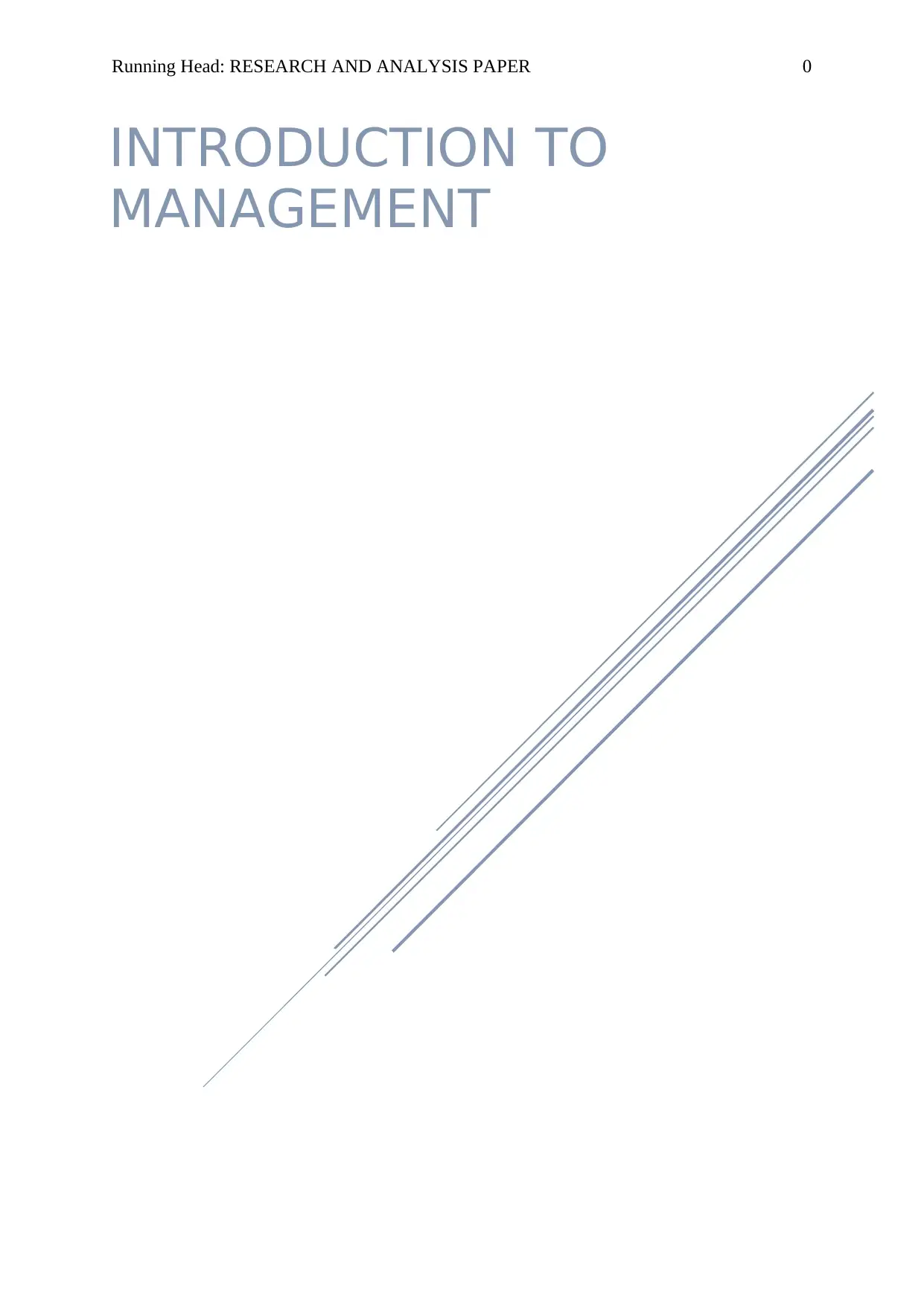
Running Head: RESEARCH AND ANALYSIS PAPER 0
INTRODUCTION TO
MANAGEMENT
INTRODUCTION TO
MANAGEMENT
Paraphrase This Document
Need a fresh take? Get an instant paraphrase of this document with our AI Paraphraser
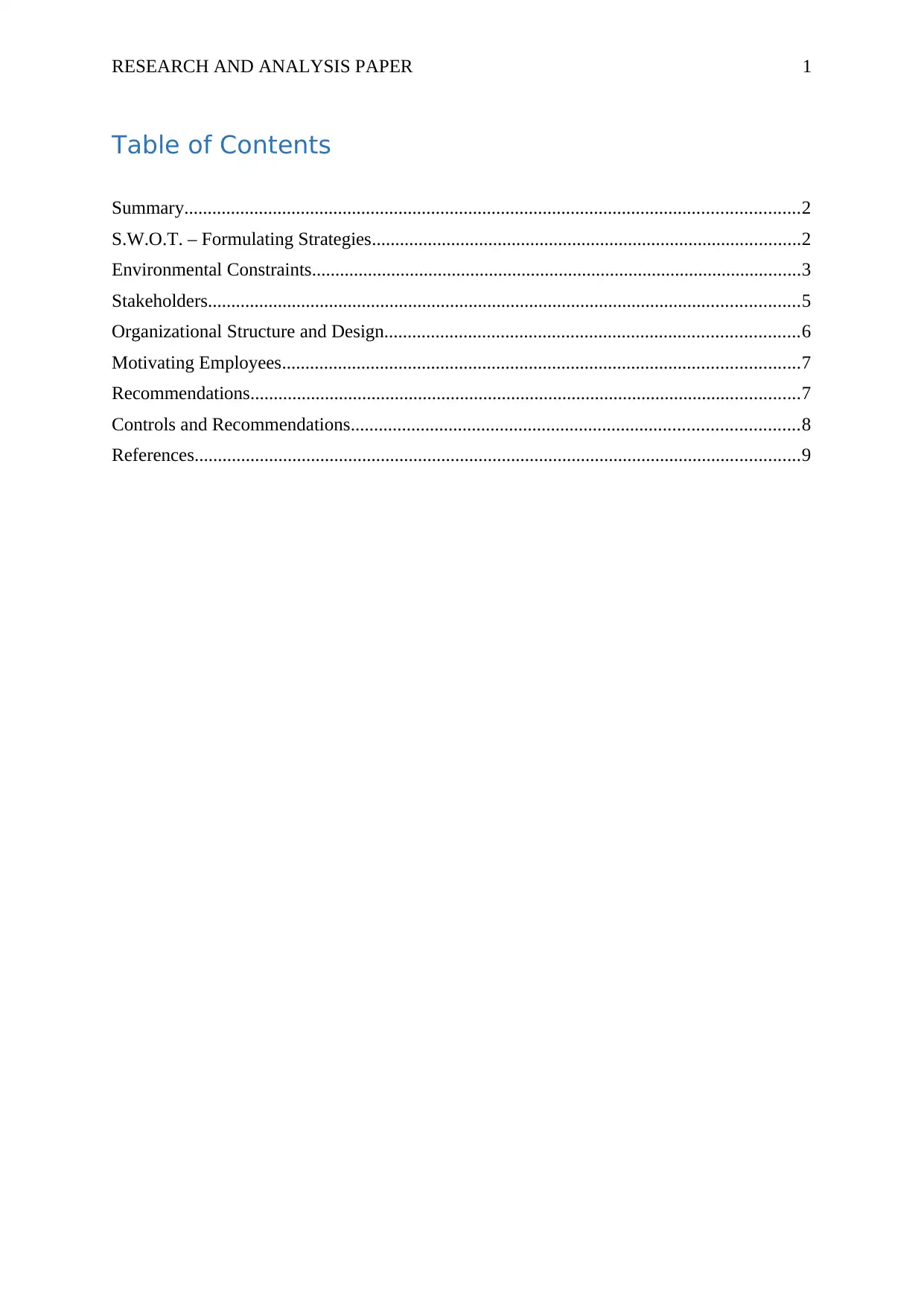
RESEARCH AND ANALYSIS PAPER 1
Table of Contents
Summary....................................................................................................................................2
S.W.O.T. – Formulating Strategies............................................................................................2
Environmental Constraints.........................................................................................................3
Stakeholders...............................................................................................................................5
Organizational Structure and Design.........................................................................................6
Motivating Employees...............................................................................................................7
Recommendations......................................................................................................................7
Controls and Recommendations................................................................................................8
References..................................................................................................................................9
Table of Contents
Summary....................................................................................................................................2
S.W.O.T. – Formulating Strategies............................................................................................2
Environmental Constraints.........................................................................................................3
Stakeholders...............................................................................................................................5
Organizational Structure and Design.........................................................................................6
Motivating Employees...............................................................................................................7
Recommendations......................................................................................................................7
Controls and Recommendations................................................................................................8
References..................................................................................................................................9
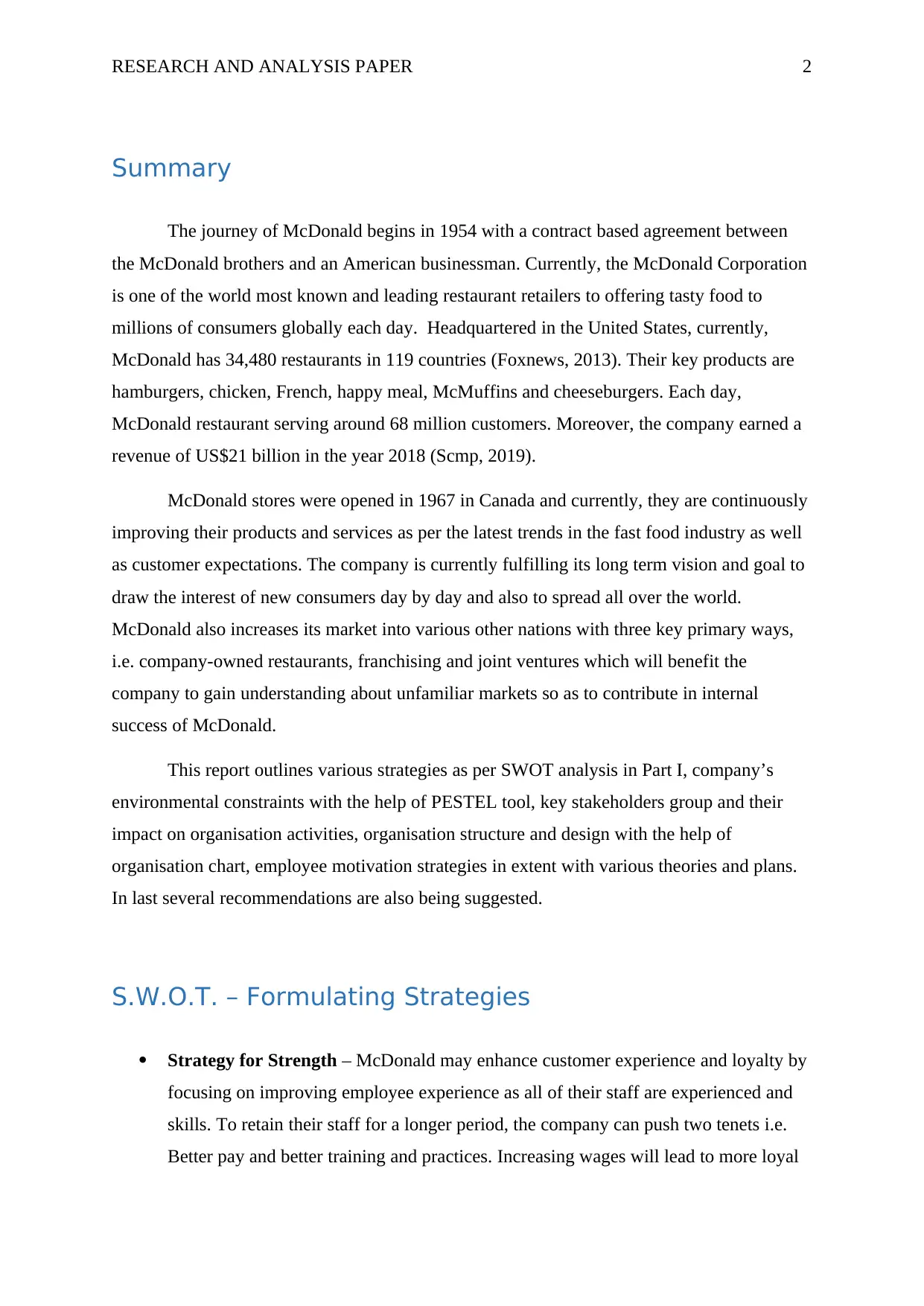
RESEARCH AND ANALYSIS PAPER 2
Summary
The journey of McDonald begins in 1954 with a contract based agreement between
the McDonald brothers and an American businessman. Currently, the McDonald Corporation
is one of the world most known and leading restaurant retailers to offering tasty food to
millions of consumers globally each day. Headquartered in the United States, currently,
McDonald has 34,480 restaurants in 119 countries (Foxnews, 2013). Their key products are
hamburgers, chicken, French, happy meal, McMuffins and cheeseburgers. Each day,
McDonald restaurant serving around 68 million customers. Moreover, the company earned a
revenue of US$21 billion in the year 2018 (Scmp, 2019).
McDonald stores were opened in 1967 in Canada and currently, they are continuously
improving their products and services as per the latest trends in the fast food industry as well
as customer expectations. The company is currently fulfilling its long term vision and goal to
draw the interest of new consumers day by day and also to spread all over the world.
McDonald also increases its market into various other nations with three key primary ways,
i.e. company-owned restaurants, franchising and joint ventures which will benefit the
company to gain understanding about unfamiliar markets so as to contribute in internal
success of McDonald.
This report outlines various strategies as per SWOT analysis in Part I, company’s
environmental constraints with the help of PESTEL tool, key stakeholders group and their
impact on organisation activities, organisation structure and design with the help of
organisation chart, employee motivation strategies in extent with various theories and plans.
In last several recommendations are also being suggested.
S.W.O.T. – Formulating Strategies
Strategy for Strength – McDonald may enhance customer experience and loyalty by
focusing on improving employee experience as all of their staff are experienced and
skills. To retain their staff for a longer period, the company can push two tenets i.e.
Better pay and better training and practices. Increasing wages will lead to more loyal
Summary
The journey of McDonald begins in 1954 with a contract based agreement between
the McDonald brothers and an American businessman. Currently, the McDonald Corporation
is one of the world most known and leading restaurant retailers to offering tasty food to
millions of consumers globally each day. Headquartered in the United States, currently,
McDonald has 34,480 restaurants in 119 countries (Foxnews, 2013). Their key products are
hamburgers, chicken, French, happy meal, McMuffins and cheeseburgers. Each day,
McDonald restaurant serving around 68 million customers. Moreover, the company earned a
revenue of US$21 billion in the year 2018 (Scmp, 2019).
McDonald stores were opened in 1967 in Canada and currently, they are continuously
improving their products and services as per the latest trends in the fast food industry as well
as customer expectations. The company is currently fulfilling its long term vision and goal to
draw the interest of new consumers day by day and also to spread all over the world.
McDonald also increases its market into various other nations with three key primary ways,
i.e. company-owned restaurants, franchising and joint ventures which will benefit the
company to gain understanding about unfamiliar markets so as to contribute in internal
success of McDonald.
This report outlines various strategies as per SWOT analysis in Part I, company’s
environmental constraints with the help of PESTEL tool, key stakeholders group and their
impact on organisation activities, organisation structure and design with the help of
organisation chart, employee motivation strategies in extent with various theories and plans.
In last several recommendations are also being suggested.
S.W.O.T. – Formulating Strategies
Strategy for Strength – McDonald may enhance customer experience and loyalty by
focusing on improving employee experience as all of their staff are experienced and
skills. To retain their staff for a longer period, the company can push two tenets i.e.
Better pay and better training and practices. Increasing wages will lead to more loyal
⊘ This is a preview!⊘
Do you want full access?
Subscribe today to unlock all pages.

Trusted by 1+ million students worldwide
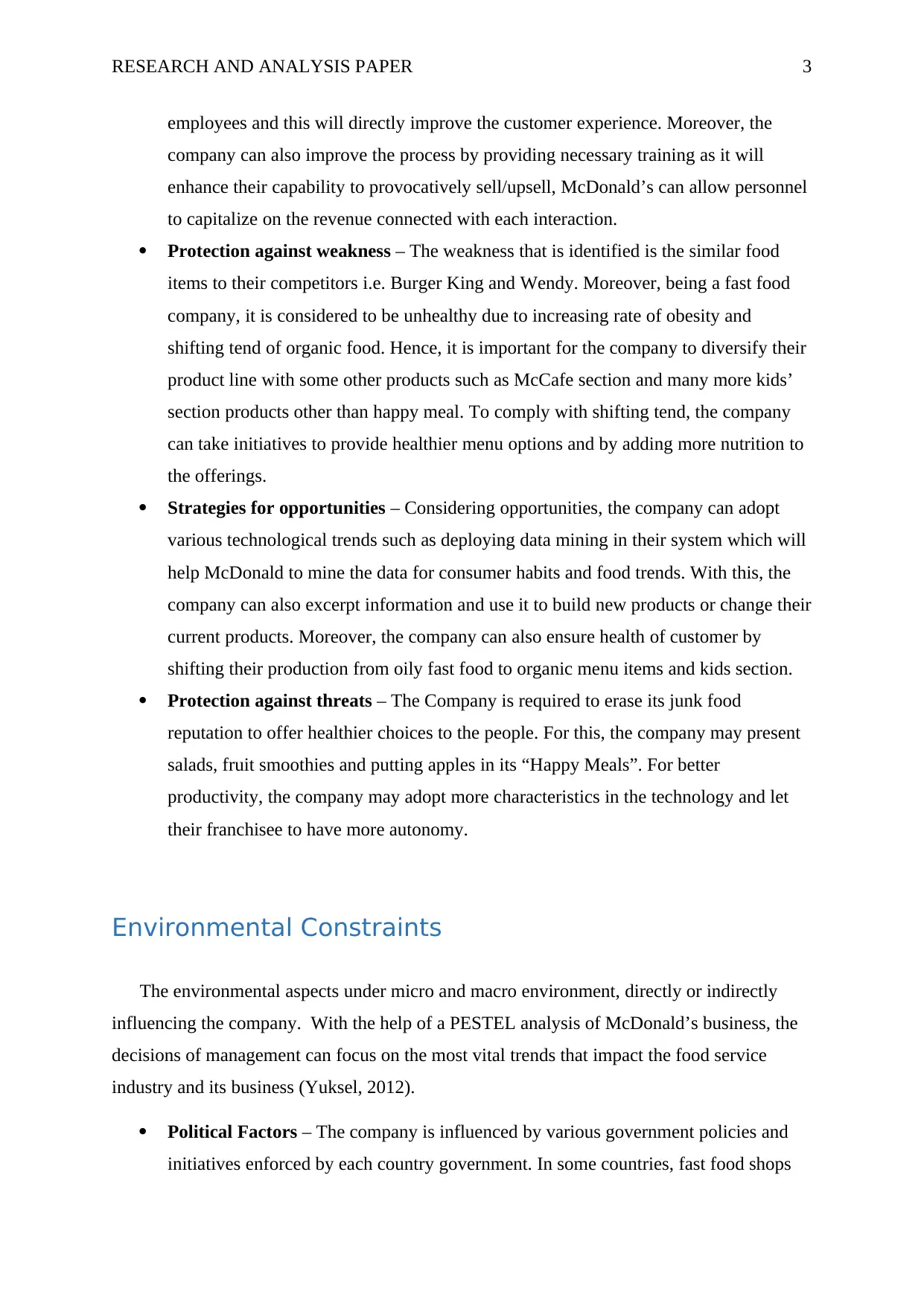
RESEARCH AND ANALYSIS PAPER 3
employees and this will directly improve the customer experience. Moreover, the
company can also improve the process by providing necessary training as it will
enhance their capability to provocatively sell/upsell, McDonald’s can allow personnel
to capitalize on the revenue connected with each interaction.
Protection against weakness – The weakness that is identified is the similar food
items to their competitors i.e. Burger King and Wendy. Moreover, being a fast food
company, it is considered to be unhealthy due to increasing rate of obesity and
shifting tend of organic food. Hence, it is important for the company to diversify their
product line with some other products such as McCafe section and many more kids’
section products other than happy meal. To comply with shifting tend, the company
can take initiatives to provide healthier menu options and by adding more nutrition to
the offerings.
Strategies for opportunities – Considering opportunities, the company can adopt
various technological trends such as deploying data mining in their system which will
help McDonald to mine the data for consumer habits and food trends. With this, the
company can also excerpt information and use it to build new products or change their
current products. Moreover, the company can also ensure health of customer by
shifting their production from oily fast food to organic menu items and kids section.
Protection against threats – The Company is required to erase its junk food
reputation to offer healthier choices to the people. For this, the company may present
salads, fruit smoothies and putting apples in its “Happy Meals”. For better
productivity, the company may adopt more characteristics in the technology and let
their franchisee to have more autonomy.
Environmental Constraints
The environmental aspects under micro and macro environment, directly or indirectly
influencing the company. With the help of a PESTEL analysis of McDonald’s business, the
decisions of management can focus on the most vital trends that impact the food service
industry and its business (Yuksel, 2012).
Political Factors – The company is influenced by various government policies and
initiatives enforced by each country government. In some countries, fast food shops
employees and this will directly improve the customer experience. Moreover, the
company can also improve the process by providing necessary training as it will
enhance their capability to provocatively sell/upsell, McDonald’s can allow personnel
to capitalize on the revenue connected with each interaction.
Protection against weakness – The weakness that is identified is the similar food
items to their competitors i.e. Burger King and Wendy. Moreover, being a fast food
company, it is considered to be unhealthy due to increasing rate of obesity and
shifting tend of organic food. Hence, it is important for the company to diversify their
product line with some other products such as McCafe section and many more kids’
section products other than happy meal. To comply with shifting tend, the company
can take initiatives to provide healthier menu options and by adding more nutrition to
the offerings.
Strategies for opportunities – Considering opportunities, the company can adopt
various technological trends such as deploying data mining in their system which will
help McDonald to mine the data for consumer habits and food trends. With this, the
company can also excerpt information and use it to build new products or change their
current products. Moreover, the company can also ensure health of customer by
shifting their production from oily fast food to organic menu items and kids section.
Protection against threats – The Company is required to erase its junk food
reputation to offer healthier choices to the people. For this, the company may present
salads, fruit smoothies and putting apples in its “Happy Meals”. For better
productivity, the company may adopt more characteristics in the technology and let
their franchisee to have more autonomy.
Environmental Constraints
The environmental aspects under micro and macro environment, directly or indirectly
influencing the company. With the help of a PESTEL analysis of McDonald’s business, the
decisions of management can focus on the most vital trends that impact the food service
industry and its business (Yuksel, 2012).
Political Factors – The company is influenced by various government policies and
initiatives enforced by each country government. In some countries, fast food shops
Paraphrase This Document
Need a fresh take? Get an instant paraphrase of this document with our AI Paraphraser
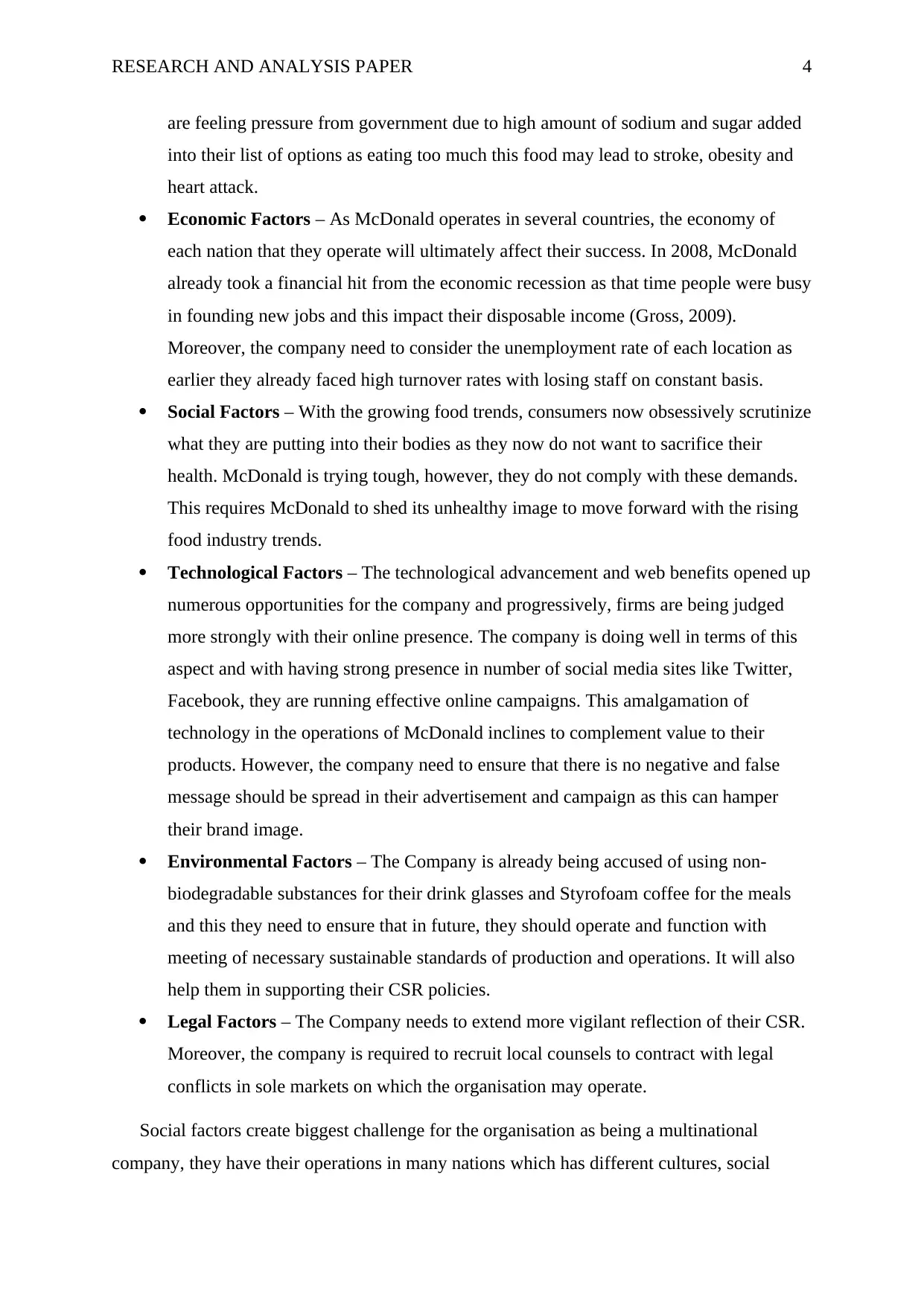
RESEARCH AND ANALYSIS PAPER 4
are feeling pressure from government due to high amount of sodium and sugar added
into their list of options as eating too much this food may lead to stroke, obesity and
heart attack.
Economic Factors – As McDonald operates in several countries, the economy of
each nation that they operate will ultimately affect their success. In 2008, McDonald
already took a financial hit from the economic recession as that time people were busy
in founding new jobs and this impact their disposable income (Gross, 2009).
Moreover, the company need to consider the unemployment rate of each location as
earlier they already faced high turnover rates with losing staff on constant basis.
Social Factors – With the growing food trends, consumers now obsessively scrutinize
what they are putting into their bodies as they now do not want to sacrifice their
health. McDonald is trying tough, however, they do not comply with these demands.
This requires McDonald to shed its unhealthy image to move forward with the rising
food industry trends.
Technological Factors – The technological advancement and web benefits opened up
numerous opportunities for the company and progressively, firms are being judged
more strongly with their online presence. The company is doing well in terms of this
aspect and with having strong presence in number of social media sites like Twitter,
Facebook, they are running effective online campaigns. This amalgamation of
technology in the operations of McDonald inclines to complement value to their
products. However, the company need to ensure that there is no negative and false
message should be spread in their advertisement and campaign as this can hamper
their brand image.
Environmental Factors – The Company is already being accused of using non-
biodegradable substances for their drink glasses and Styrofoam coffee for the meals
and this they need to ensure that in future, they should operate and function with
meeting of necessary sustainable standards of production and operations. It will also
help them in supporting their CSR policies.
Legal Factors – The Company needs to extend more vigilant reflection of their CSR.
Moreover, the company is required to recruit local counsels to contract with legal
conflicts in sole markets on which the organisation may operate.
Social factors create biggest challenge for the organisation as being a multinational
company, they have their operations in many nations which has different cultures, social
are feeling pressure from government due to high amount of sodium and sugar added
into their list of options as eating too much this food may lead to stroke, obesity and
heart attack.
Economic Factors – As McDonald operates in several countries, the economy of
each nation that they operate will ultimately affect their success. In 2008, McDonald
already took a financial hit from the economic recession as that time people were busy
in founding new jobs and this impact their disposable income (Gross, 2009).
Moreover, the company need to consider the unemployment rate of each location as
earlier they already faced high turnover rates with losing staff on constant basis.
Social Factors – With the growing food trends, consumers now obsessively scrutinize
what they are putting into their bodies as they now do not want to sacrifice their
health. McDonald is trying tough, however, they do not comply with these demands.
This requires McDonald to shed its unhealthy image to move forward with the rising
food industry trends.
Technological Factors – The technological advancement and web benefits opened up
numerous opportunities for the company and progressively, firms are being judged
more strongly with their online presence. The company is doing well in terms of this
aspect and with having strong presence in number of social media sites like Twitter,
Facebook, they are running effective online campaigns. This amalgamation of
technology in the operations of McDonald inclines to complement value to their
products. However, the company need to ensure that there is no negative and false
message should be spread in their advertisement and campaign as this can hamper
their brand image.
Environmental Factors – The Company is already being accused of using non-
biodegradable substances for their drink glasses and Styrofoam coffee for the meals
and this they need to ensure that in future, they should operate and function with
meeting of necessary sustainable standards of production and operations. It will also
help them in supporting their CSR policies.
Legal Factors – The Company needs to extend more vigilant reflection of their CSR.
Moreover, the company is required to recruit local counsels to contract with legal
conflicts in sole markets on which the organisation may operate.
Social factors create biggest challenge for the organisation as being a multinational
company, they have their operations in many nations which has different cultures, social
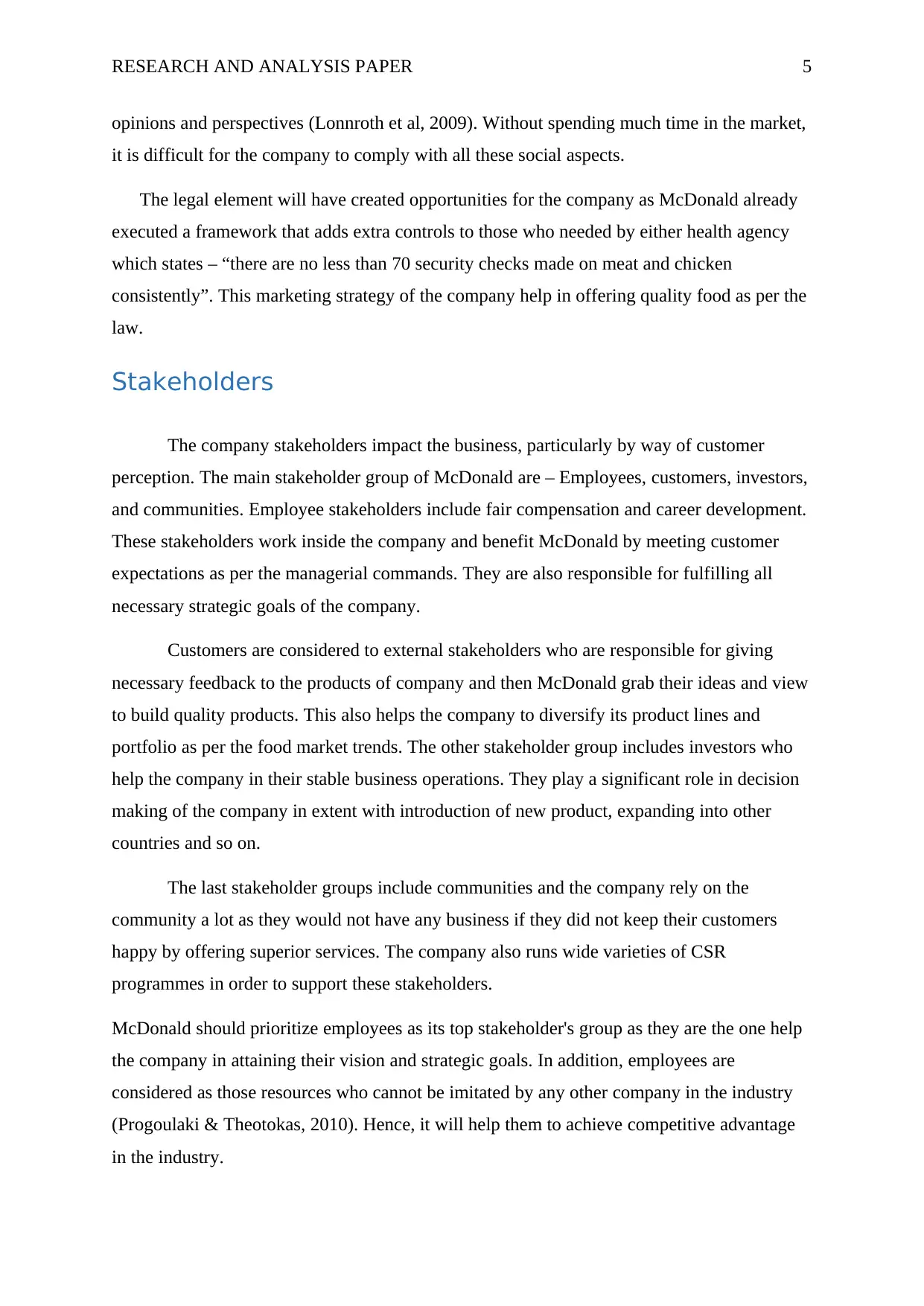
RESEARCH AND ANALYSIS PAPER 5
opinions and perspectives (Lonnroth et al, 2009). Without spending much time in the market,
it is difficult for the company to comply with all these social aspects.
The legal element will have created opportunities for the company as McDonald already
executed a framework that adds extra controls to those who needed by either health agency
which states – “there are no less than 70 security checks made on meat and chicken
consistently”. This marketing strategy of the company help in offering quality food as per the
law.
Stakeholders
The company stakeholders impact the business, particularly by way of customer
perception. The main stakeholder group of McDonald are – Employees, customers, investors,
and communities. Employee stakeholders include fair compensation and career development.
These stakeholders work inside the company and benefit McDonald by meeting customer
expectations as per the managerial commands. They are also responsible for fulfilling all
necessary strategic goals of the company.
Customers are considered to external stakeholders who are responsible for giving
necessary feedback to the products of company and then McDonald grab their ideas and view
to build quality products. This also helps the company to diversify its product lines and
portfolio as per the food market trends. The other stakeholder group includes investors who
help the company in their stable business operations. They play a significant role in decision
making of the company in extent with introduction of new product, expanding into other
countries and so on.
The last stakeholder groups include communities and the company rely on the
community a lot as they would not have any business if they did not keep their customers
happy by offering superior services. The company also runs wide varieties of CSR
programmes in order to support these stakeholders.
McDonald should prioritize employees as its top stakeholder's group as they are the one help
the company in attaining their vision and strategic goals. In addition, employees are
considered as those resources who cannot be imitated by any other company in the industry
(Progoulaki & Theotokas, 2010). Hence, it will help them to achieve competitive advantage
in the industry.
opinions and perspectives (Lonnroth et al, 2009). Without spending much time in the market,
it is difficult for the company to comply with all these social aspects.
The legal element will have created opportunities for the company as McDonald already
executed a framework that adds extra controls to those who needed by either health agency
which states – “there are no less than 70 security checks made on meat and chicken
consistently”. This marketing strategy of the company help in offering quality food as per the
law.
Stakeholders
The company stakeholders impact the business, particularly by way of customer
perception. The main stakeholder group of McDonald are – Employees, customers, investors,
and communities. Employee stakeholders include fair compensation and career development.
These stakeholders work inside the company and benefit McDonald by meeting customer
expectations as per the managerial commands. They are also responsible for fulfilling all
necessary strategic goals of the company.
Customers are considered to external stakeholders who are responsible for giving
necessary feedback to the products of company and then McDonald grab their ideas and view
to build quality products. This also helps the company to diversify its product lines and
portfolio as per the food market trends. The other stakeholder group includes investors who
help the company in their stable business operations. They play a significant role in decision
making of the company in extent with introduction of new product, expanding into other
countries and so on.
The last stakeholder groups include communities and the company rely on the
community a lot as they would not have any business if they did not keep their customers
happy by offering superior services. The company also runs wide varieties of CSR
programmes in order to support these stakeholders.
McDonald should prioritize employees as its top stakeholder's group as they are the one help
the company in attaining their vision and strategic goals. In addition, employees are
considered as those resources who cannot be imitated by any other company in the industry
(Progoulaki & Theotokas, 2010). Hence, it will help them to achieve competitive advantage
in the industry.
⊘ This is a preview!⊘
Do you want full access?
Subscribe today to unlock all pages.

Trusted by 1+ million students worldwide
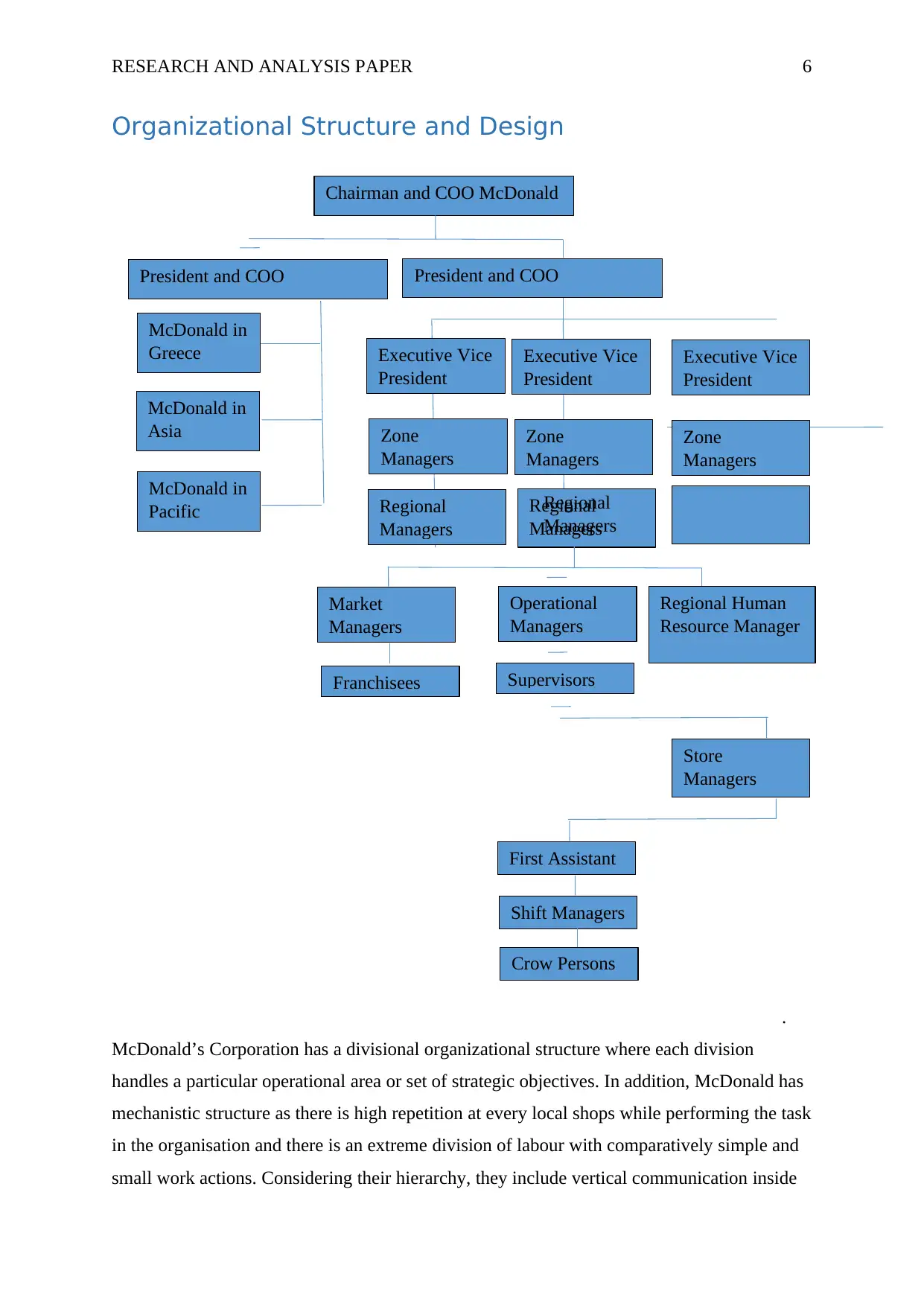
RESEARCH AND ANALYSIS PAPER 6
Organizational Structure and Design
.
McDonald’s Corporation has a divisional organizational structure where each division
handles a particular operational area or set of strategic objectives. In addition, McDonald has
mechanistic structure as there is high repetition at every local shops while performing the task
in the organisation and there is an extreme division of labour with comparatively simple and
small work actions. Considering their hierarchy, they include vertical communication inside
Chairman and COO McDonald
President and COO President and COO
McDonald in
Greece
McDonald in
Asia
McDonald in
Pacific
Executive Vice
President
Zone
Managers
Regional
Managers
Executive Vice
President
Zone
Managers
Regional
Managers
Executive Vice
President
Zone
Managers
Regional
Managers
Market
Managers
Operational
Managers
Regional Human
Resource Manager
Franchisees Supervisors
Store
Managers
First Assistant
Shift Managers
Crow Persons
Organizational Structure and Design
.
McDonald’s Corporation has a divisional organizational structure where each division
handles a particular operational area or set of strategic objectives. In addition, McDonald has
mechanistic structure as there is high repetition at every local shops while performing the task
in the organisation and there is an extreme division of labour with comparatively simple and
small work actions. Considering their hierarchy, they include vertical communication inside
Chairman and COO McDonald
President and COO President and COO
McDonald in
Greece
McDonald in
Asia
McDonald in
Pacific
Executive Vice
President
Zone
Managers
Regional
Managers
Executive Vice
President
Zone
Managers
Regional
Managers
Executive Vice
President
Zone
Managers
Regional
Managers
Market
Managers
Operational
Managers
Regional Human
Resource Manager
Franchisees Supervisors
Store
Managers
First Assistant
Shift Managers
Crow Persons
Paraphrase This Document
Need a fresh take? Get an instant paraphrase of this document with our AI Paraphraser
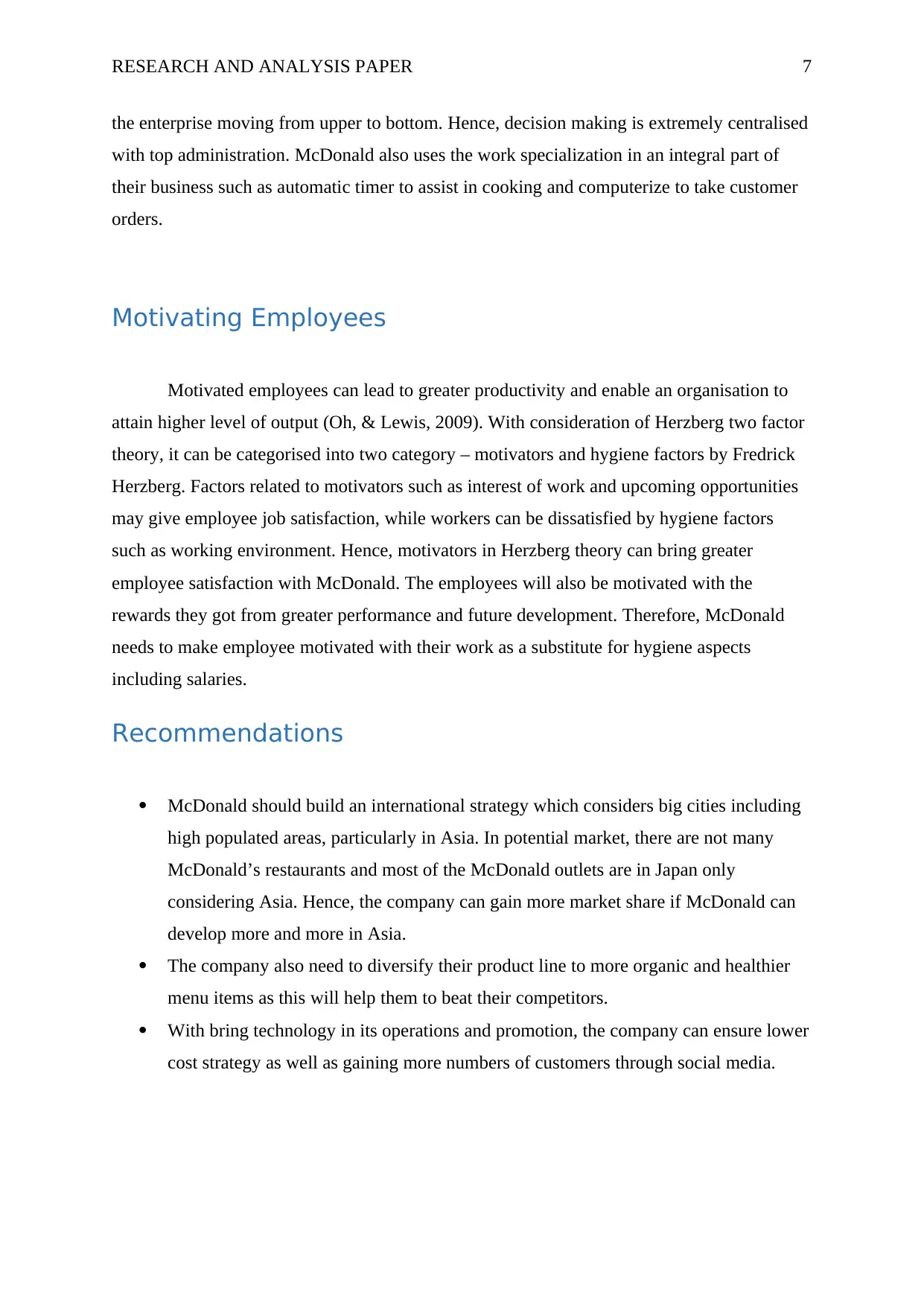
RESEARCH AND ANALYSIS PAPER 7
the enterprise moving from upper to bottom. Hence, decision making is extremely centralised
with top administration. McDonald also uses the work specialization in an integral part of
their business such as automatic timer to assist in cooking and computerize to take customer
orders.
Motivating Employees
Motivated employees can lead to greater productivity and enable an organisation to
attain higher level of output (Oh, & Lewis, 2009). With consideration of Herzberg two factor
theory, it can be categorised into two category – motivators and hygiene factors by Fredrick
Herzberg. Factors related to motivators such as interest of work and upcoming opportunities
may give employee job satisfaction, while workers can be dissatisfied by hygiene factors
such as working environment. Hence, motivators in Herzberg theory can bring greater
employee satisfaction with McDonald. The employees will also be motivated with the
rewards they got from greater performance and future development. Therefore, McDonald
needs to make employee motivated with their work as a substitute for hygiene aspects
including salaries.
Recommendations
McDonald should build an international strategy which considers big cities including
high populated areas, particularly in Asia. In potential market, there are not many
McDonald’s restaurants and most of the McDonald outlets are in Japan only
considering Asia. Hence, the company can gain more market share if McDonald can
develop more and more in Asia.
The company also need to diversify their product line to more organic and healthier
menu items as this will help them to beat their competitors.
With bring technology in its operations and promotion, the company can ensure lower
cost strategy as well as gaining more numbers of customers through social media.
the enterprise moving from upper to bottom. Hence, decision making is extremely centralised
with top administration. McDonald also uses the work specialization in an integral part of
their business such as automatic timer to assist in cooking and computerize to take customer
orders.
Motivating Employees
Motivated employees can lead to greater productivity and enable an organisation to
attain higher level of output (Oh, & Lewis, 2009). With consideration of Herzberg two factor
theory, it can be categorised into two category – motivators and hygiene factors by Fredrick
Herzberg. Factors related to motivators such as interest of work and upcoming opportunities
may give employee job satisfaction, while workers can be dissatisfied by hygiene factors
such as working environment. Hence, motivators in Herzberg theory can bring greater
employee satisfaction with McDonald. The employees will also be motivated with the
rewards they got from greater performance and future development. Therefore, McDonald
needs to make employee motivated with their work as a substitute for hygiene aspects
including salaries.
Recommendations
McDonald should build an international strategy which considers big cities including
high populated areas, particularly in Asia. In potential market, there are not many
McDonald’s restaurants and most of the McDonald outlets are in Japan only
considering Asia. Hence, the company can gain more market share if McDonald can
develop more and more in Asia.
The company also need to diversify their product line to more organic and healthier
menu items as this will help them to beat their competitors.
With bring technology in its operations and promotion, the company can ensure lower
cost strategy as well as gaining more numbers of customers through social media.
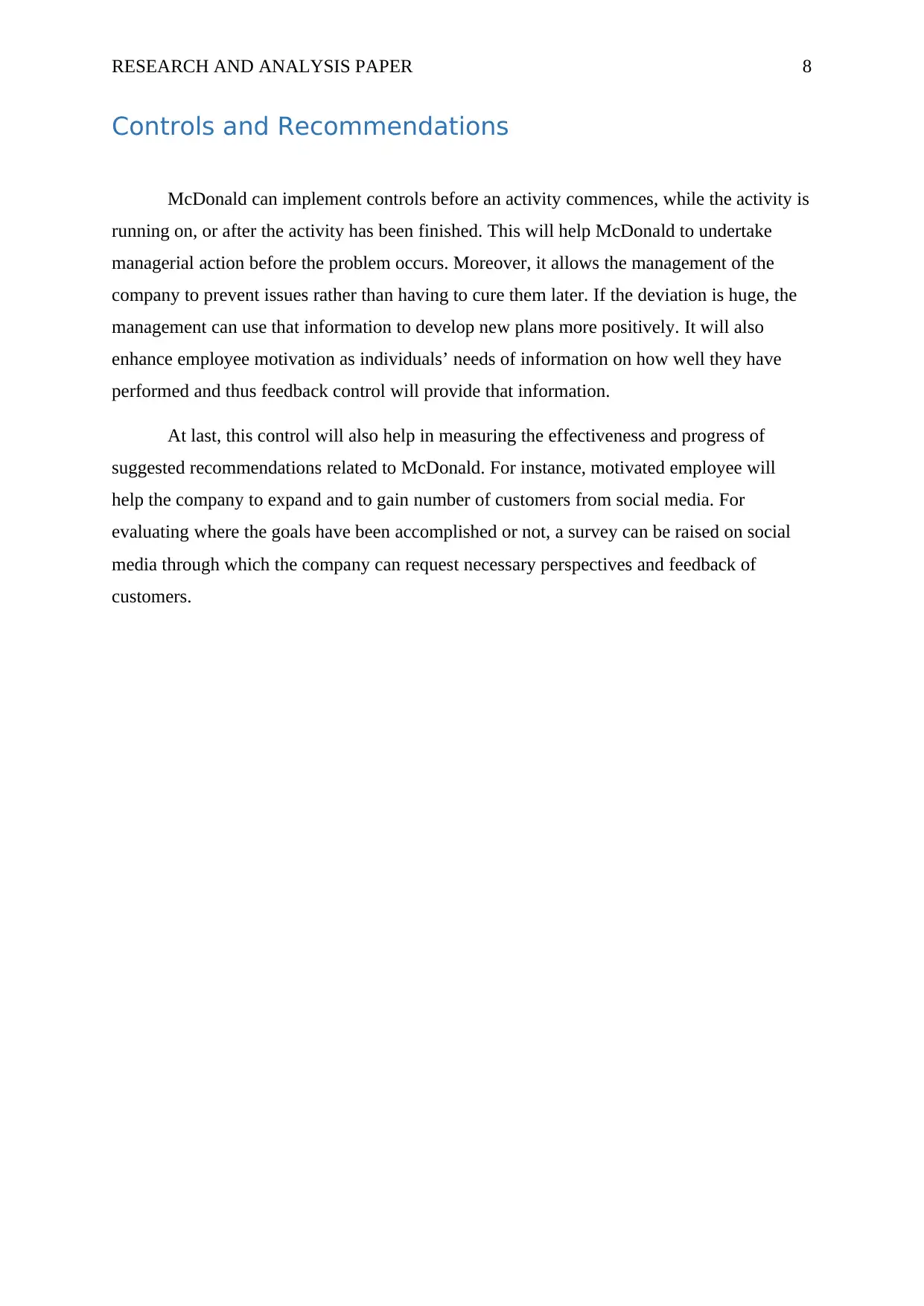
RESEARCH AND ANALYSIS PAPER 8
Controls and Recommendations
McDonald can implement controls before an activity commences, while the activity is
running on, or after the activity has been finished. This will help McDonald to undertake
managerial action before the problem occurs. Moreover, it allows the management of the
company to prevent issues rather than having to cure them later. If the deviation is huge, the
management can use that information to develop new plans more positively. It will also
enhance employee motivation as individuals’ needs of information on how well they have
performed and thus feedback control will provide that information.
At last, this control will also help in measuring the effectiveness and progress of
suggested recommendations related to McDonald. For instance, motivated employee will
help the company to expand and to gain number of customers from social media. For
evaluating where the goals have been accomplished or not, a survey can be raised on social
media through which the company can request necessary perspectives and feedback of
customers.
Controls and Recommendations
McDonald can implement controls before an activity commences, while the activity is
running on, or after the activity has been finished. This will help McDonald to undertake
managerial action before the problem occurs. Moreover, it allows the management of the
company to prevent issues rather than having to cure them later. If the deviation is huge, the
management can use that information to develop new plans more positively. It will also
enhance employee motivation as individuals’ needs of information on how well they have
performed and thus feedback control will provide that information.
At last, this control will also help in measuring the effectiveness and progress of
suggested recommendations related to McDonald. For instance, motivated employee will
help the company to expand and to gain number of customers from social media. For
evaluating where the goals have been accomplished or not, a survey can be raised on social
media through which the company can request necessary perspectives and feedback of
customers.
⊘ This is a preview!⊘
Do you want full access?
Subscribe today to unlock all pages.

Trusted by 1+ million students worldwide
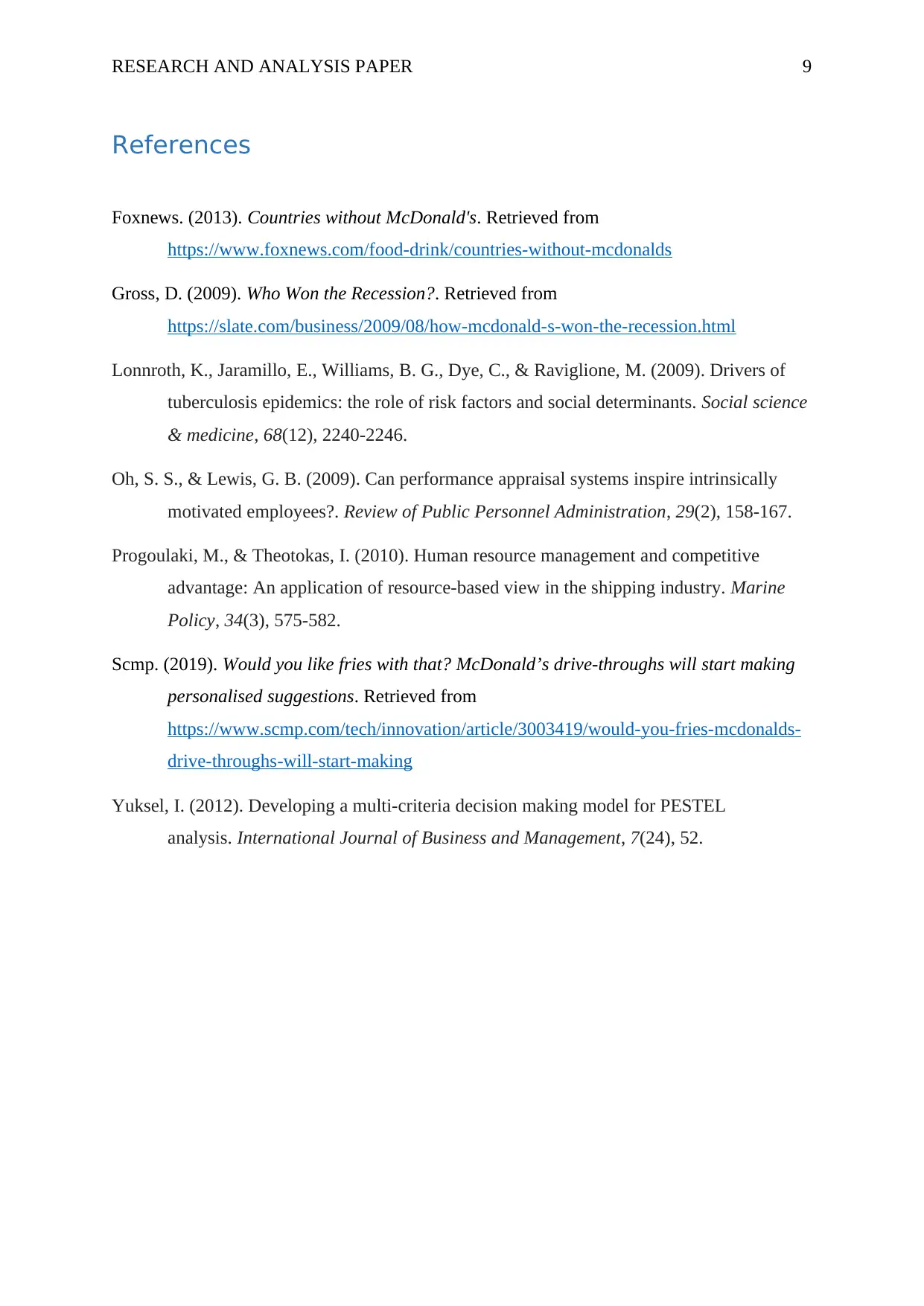
RESEARCH AND ANALYSIS PAPER 9
References
Foxnews. (2013). Countries without McDonald's. Retrieved from
https://www.foxnews.com/food-drink/countries-without-mcdonalds
Gross, D. (2009). Who Won the Recession?. Retrieved from
https://slate.com/business/2009/08/how-mcdonald-s-won-the-recession.html
Lonnroth, K., Jaramillo, E., Williams, B. G., Dye, C., & Raviglione, M. (2009). Drivers of
tuberculosis epidemics: the role of risk factors and social determinants. Social science
& medicine, 68(12), 2240-2246.
Oh, S. S., & Lewis, G. B. (2009). Can performance appraisal systems inspire intrinsically
motivated employees?. Review of Public Personnel Administration, 29(2), 158-167.
Progoulaki, M., & Theotokas, I. (2010). Human resource management and competitive
advantage: An application of resource-based view in the shipping industry. Marine
Policy, 34(3), 575-582.
Scmp. (2019). Would you like fries with that? McDonald’s drive-throughs will start making
personalised suggestions. Retrieved from
https://www.scmp.com/tech/innovation/article/3003419/would-you-fries-mcdonalds-
drive-throughs-will-start-making
Yuksel, I. (2012). Developing a multi-criteria decision making model for PESTEL
analysis. International Journal of Business and Management, 7(24), 52.
References
Foxnews. (2013). Countries without McDonald's. Retrieved from
https://www.foxnews.com/food-drink/countries-without-mcdonalds
Gross, D. (2009). Who Won the Recession?. Retrieved from
https://slate.com/business/2009/08/how-mcdonald-s-won-the-recession.html
Lonnroth, K., Jaramillo, E., Williams, B. G., Dye, C., & Raviglione, M. (2009). Drivers of
tuberculosis epidemics: the role of risk factors and social determinants. Social science
& medicine, 68(12), 2240-2246.
Oh, S. S., & Lewis, G. B. (2009). Can performance appraisal systems inspire intrinsically
motivated employees?. Review of Public Personnel Administration, 29(2), 158-167.
Progoulaki, M., & Theotokas, I. (2010). Human resource management and competitive
advantage: An application of resource-based view in the shipping industry. Marine
Policy, 34(3), 575-582.
Scmp. (2019). Would you like fries with that? McDonald’s drive-throughs will start making
personalised suggestions. Retrieved from
https://www.scmp.com/tech/innovation/article/3003419/would-you-fries-mcdonalds-
drive-throughs-will-start-making
Yuksel, I. (2012). Developing a multi-criteria decision making model for PESTEL
analysis. International Journal of Business and Management, 7(24), 52.
1 out of 10
Related Documents
Your All-in-One AI-Powered Toolkit for Academic Success.
+13062052269
info@desklib.com
Available 24*7 on WhatsApp / Email
![[object Object]](/_next/static/media/star-bottom.7253800d.svg)
Unlock your academic potential
Copyright © 2020–2025 A2Z Services. All Rights Reserved. Developed and managed by ZUCOL.




